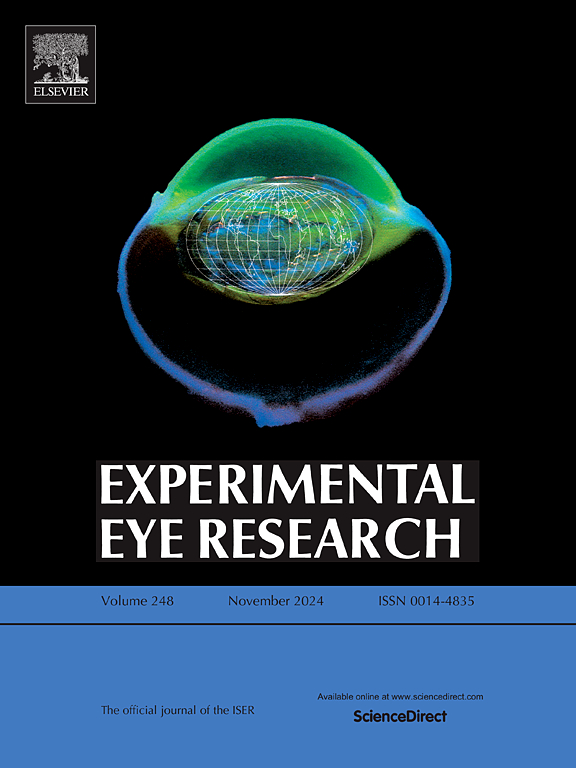The effects of different riboflavin concentrations and infiltration times on rabbit scleral crosslinking
IF 3
2区 医学
Q1 OPHTHALMOLOGY
引用次数: 0
Abstract
To explore the photosensitizer content, diffusion depth and crosslinking effects in rabbit sclera with different riboflavin (Rf) infiltration times and concentrations. For the fluorescence study, rabbit eyes were infiltrated in Rf solutions of different concentrations for different durations on the sclera. The scleral Rf infiltration depth and fluorescence intensity were analyzed with an LSM710 confocal microscope, and the Rf content was detected by the absorbance of the sclera homogenate supernatant. Ultraviolet A was used to perform scleral crosslinking (SXL). The effect of SXL was evaluated using uniaxial tensile testing and enzymatic resistance testing, and the biological safety was evaluated using HE and TUNEL staining. Transmission electron microscopy (TEM) observation was used to clarify the change in collagen fiber diameter. Rf quickly infiltrated the full scleral thickness at 0.05 % concentration for 5 min. The scleral Rf content was not statistically different after infiltration with 0.5 % Rf for 5 min or 10 min. The scleral tissues of the 0.1 % Rf-30 min group and the 0.5 % Rf-5 min group were digested completely within 22.7 ± 1.9 h and 25.3 ± 5.5 h, respectively. At 10 % strain, the Young's modulus of the 0.5 % Rf-5 min group was significantly higher than the control group (P = 0.0004). No obvious structural damage was observed in the retina or sclera, and the diameter of collagen fibers in the outer and middle scleral layers increased significantly after SXL. Ultimately, Rf infiltration at a concentration of 0.5 % for 5 min helped to shorten operation time and improve SXL effects.
不同核黄素浓度和浸润时间对兔巩膜交联的影响
探讨不同核黄素(Rf)浸润次数和浓度下光敏剂在兔巩膜中的含量、扩散深度及交联效应。在荧光研究中,用不同浓度的Rf溶液在兔眼巩膜上浸润不同时间。用LSM710共聚焦显微镜分析巩膜Rf浸润深度和荧光强度,用巩膜匀浆上清吸光度检测Rf含量。紫外线A用于巩膜交联(SXL)。采用单轴拉伸试验和酶促抗性试验评价SXL的作用,采用HE和TUNEL染色评价SXL的生物安全性。透射电镜观察胶原纤维直径的变化。0.05%浓度下Rf快速浸润巩膜全厚度,浸润时间为5 min, 0.5% Rf浸润时间为5 min和10 min,巩膜Rf含量无统计学差异。0.1% Rf-30 min组和0.5% Rf-5 min组巩膜组织分别在22.7±1.9 h和25.3±5.5 h内被完全消化。在10%应变下,0.5% Rf-5 min组的杨氏模量显著高于对照组(P = 0.0004)。视网膜和巩膜未见明显结构损伤,巩膜外中层胶原纤维直径明显增加。最终,0.5%浓度的Rf浸润5min有助于缩短操作时间,提高SXL效果。
本文章由计算机程序翻译,如有差异,请以英文原文为准。
求助全文
约1分钟内获得全文
求助全文
来源期刊

Experimental eye research
医学-眼科学
CiteScore
6.80
自引率
5.90%
发文量
323
审稿时长
66 days
期刊介绍:
The primary goal of Experimental Eye Research is to publish original research papers on all aspects of experimental biology of the eye and ocular tissues that seek to define the mechanisms of normal function and/or disease. Studies of ocular tissues that encompass the disciplines of cell biology, developmental biology, genetics, molecular biology, physiology, biochemistry, biophysics, immunology or microbiology are most welcomed. Manuscripts that are purely clinical or in a surgical area of ophthalmology are not appropriate for submission to Experimental Eye Research and if received will be returned without review.
 求助内容:
求助内容: 应助结果提醒方式:
应助结果提醒方式:


